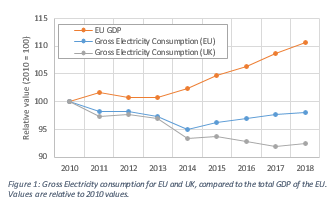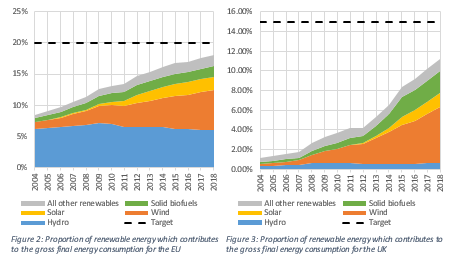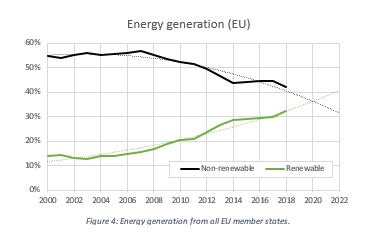27/06/2019
For years we have heard many reports discussing one of the most important issues of our time. Climate change. One obvious solution is the full change from fossil fuel based energy sources to renewable energy sources. In this blog I will explore trends in renewable energy consumption and generation, and whether renewable energy sources may overtake non-renewable sources in the future.
The total energy consumption in Europe has remained relatively stable since the early 2010s. In fact, despite a raising average GDP, average energy consumption still remains below 2010 levels. Compared to the rest of Europe, the UK has seen a decline in the energy consumption, from 2010, as shown below in figure 1.
Despite energy consumption remaining relatively constant in recent years, the European Union and other nations are making efforts to transfer to renewable energy sources such as Hydro, solar, wind and biomass. In 2009 the EU set targets for member states to increase the share of energy consumed from renewable energy sources through the Renewables Directive. The Renewables Directive required the EU to reach 20% of energy in gross final consumption of energy from renewable sources by 2020, The UK is required to reach 15%. The figures below shows the proportion of renewable energy which contributes to the gross final energy consumption for the EU and UK. The question remains, can renewable energy sources provide us with enough energy, and when will we see this possibility.
From current data, the trend for renewable energy consumption is indeed a positive one. In Europe as a whole, use of renewable energy is up by around 50% from 2009. The biggest increase for a single technology is around a 400% increase in solar power. In the UK the picture is even more positive, where renewable energy consumption has increased by around 250%, with the best performing technology also being solar which increased by a staggering 25 times since 2009.
Therefore, there is a promising trend of increasing renewable energy use in the EU and the UK. When we consider only the energy generation, comparing generation from renewable energies to non-renewable energy sources such as coal, lignite, gas and other fossil fuels provides a view on the direction of the energy market in Europe. There is a clear change in energy generation from non-renewables to renewables. Extrapolating the data shows that sometime within the next couple of years we may even see the share of renewable energy generation overtaking non-renewable generation. One key driver for the popularity and uptake of a new energy technology is the price. The date which the price of coal energy is to be overtaken by renewable energy is much publicised as the “Coal crossover”. In the US, reports have determined that almost three quarters of coal production is more expensive than renewables, with estimations that the coal industry will be out-competed on cost by 2025.
One key driver for the popularity and uptake of a new energy technology is the price. The date which the price of coal energy is to be overtaken by renewable energy is much publicised as the “Coal crossover”. In the US, reports have determined that almost three quarters of coal production is more expensive than renewables, with estimations that the coal industry will be out-competed on cost by 2025.
The increased interest in renewable energy sources provides some appealing opportunities for the future. With the trends seen above, we can see that more people are willing to invest in renewable energy sources and more are making an effort to innovate. Inventors will be more interested in developing new technologies to improve the efficiency and output of renewable energy technologies. To protect such innovations it is expected that there will also be an increase in patent protection.
In a recent blog, Alex Cope discussed whether technology is rising to the challenge of climate change. In his blog, Alex showed that there is a clear trend of increasing patent filings for technologies in the renewable energy generation sector. The data discussed in Alex’s blog along with the above discussed trends in renewable energy generation demonstrate that renewable energy sources are becoming an increasing part of our lives and soon we may be relying on them solely for our energy needs.
As the price of renewable energy technologies goes down, smaller companies will be able to enter the market and also gain protection for their technologies. Therefore, the renewable energy sector is expected to be of increasing importance in the patent world, and we expect to see the volume of patent filings for renewable energy technologies to increase in the coming years.
The data used for this blog was from the Sandbag European Power Sector 2018 report, alongside data from EUROSTAT.
This article is for general information only. Its content is not a statement of the law on any subject and does not constitute advice. Please contact Reddie & Grose LLP for advice before taking any action in reliance on it.

